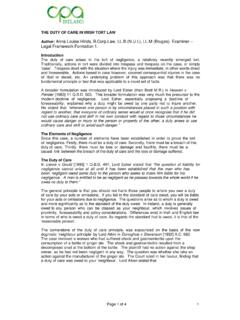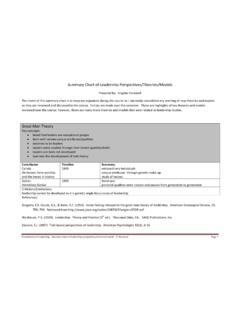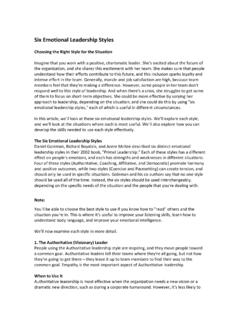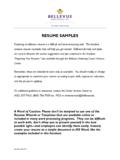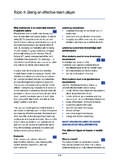Transcription of STRATEGY AND THE IMPORTANCE OF STRATEGIC …
1 Page 1 of 9 STRATEGY AND THE IMPORTANCE OF STRATEGIC leadership By James Redmond, BBS, MBS, ACMA: Examiner - Professional 2 STRATEGY & leadership You've got to eat while you dream. You've got to deliver on short-range commitments, while you develop a long-range STRATEGY and vision and implement it. The success of doing both. Walking and chewing gum if you will. Getting it done in the short-range, and delivering a long-range plan, and executing on that. Jack Welch, former CEO of General Electric Introduction The business world is changing more rapidly and more dramatically than ever before: technology, globalisation, competition, the rise of Asian business superpowers, have fundamentally reshaped the business environment. To deal with such a complex and dynamic environment, organisations need experienced people with well-developed leadership abilities and acumen. This article will briefly address the nature and IMPORTANCE of organisational leadership , and will then focus primarily on leadership at the senior management level of the organisation, and in particular on the nature, the roles and the leadership styles of this critical group of management.
2 The Nature of leadership leadership permeates society, but from a business perspective it is the identification, development, and use of organisational leadership which is critical to organisational performance. It is generally accepted (see for example, House and Podsakoff, 1995) that leadership is a key determinant of organisational performance: leaders make a difference. For example, when one reviews the success of Irish firms, it is easy to conclude that senior managers such a Michael O Leary of Ryanair, Denis Brosnan formerly of Kerry Group, Myles Lee and Albert Manifold CPA of CRH have been integral to the success of their respective businesses. Similarly, when one reviews the collapse of the main Irish banks, it is difficult to escape the conclusion that poor leadership was a significant contributing factor to what happened. While leadership is clearly important, there is debate about the process and nature of leadership .
3 Robbins et al (2010) define leadership as ..the ability to influence a group toward the achievement of a vision or a set of goals. Daft views leadership as ..the ability to influence people toward the attainment of organisational goals. Robbins et al (2010) distinguishes the leadership role from the managerial role, stating that managers merely use the authority inherent in formal positions to obtain compliance from organisational members. An effective manager will however have to possess and utilise significant leadership ability. Page 2 of 9 leadership Theories As a starting point in looking at STRATEGIC leadership , it is useful to briefly highlight the evolution of leadership theories. leadership Trait Theory tried to identify the personality traits associated with being a leader. The main issue with trait theory is that there is no accepted set of traits that can be linked to effective leadership .
4 A more current perspective on trait theory, and more politically correct, is that everyone has varying levels of necessary leadership traits, and it is how one uses them that matters. The sense today is more that leaders can be developed; they are not just born. More recently, Kirkpatrick and Locke (1991) identified the following wider trait components of leadership : 1. Drive 2. leadership motivation 3. Integrity 4. Self-confidence 5. Emotional Maturity leadership Behavioural Theory tries to better understand what effective leaders do; that is, their behaviours. Behavioural theory suggests that there are two categories of leadership behaviour: Task Centred and People Centred. Well known research in this area includes research from Ohio State University and from the University of Michigan, as well as Blake and Mouton s Managerial Grid . Task behaviours Emphasises roles and tasks Plans and schedules work Sets performance standards and procedures People Behaviours Friendly and supportive Shows trust and confidence Concerned with employees welfare Contingency Theories attempt to analyse the IMPORTANCE of the situation to the impact of the leader, and conclude that leadership effectiveness depends on the context in which the leader must operate.
5 In other words, a leadership approach that may be successful in one organisation, or at one point in time, may not be successful in another organisation or another point in time. Two popular contingency theories are Fielder s leadership Contingency Theory and House s Path-Goal Theory. A well-known example of the impact to situational factors on leadership is illustrated by Simmons (2007). He describes John Scully s tenure as CEO of Apple. Scully was already a very successful senior manager in PepsiCo, when he moved to California to become the CEO of Apple. It was his opinion that Scully s lack of experience in the computer sector, his more traditional management style and his failure to fully understand the industry ultimately lead to Apple falling to fulfil its potential and build on their technological advantages, at least at that time. Page 3 of 9 There are a variety of more contemporary theories or perspectives on leadership , including substitutes for leadership , authentic leadership , charismatic leadership and transformational leadership .
6 For example, in transformational / charismatic leadership , leaders empower and coach followers while the followers closely identify with the leader. This leads to a more motivated workforce that performs to a high level and embraces major changes. The transformational and charismatic leadership styles share similarities with Rowe s STRATEGIC leadership Style discussed below. The Senior Management Team and leadership Organisations, especially large organisations, are very complex and need a range and depth of knowledge and experience to be effectively managed: this is provided by the senior management team. The analysis, insight and decisions made by this group of managers are key to the success of an organisation. Through their vison, what they say and in how they act senior management influence the thoughts, feelings and actions of people in the organisation. effective STRATEGIC leadership , and the responsibility for STRATEGIC thinking and decision-making, rests at the top of the organisation.
7 In particular the CEO, but other senior management also, must make the STRATEGIC decisions and create the organisational context which can lead to long-term organisational success. From this perspective, the senior managers and the top management team are an important STRATEGIC resource for the organisation: STRATEGIC leaders can make a competitive difference. As Hoskisson et al (2004) note, a new CEO can have a significant difference on the performance of a firm. A classic example of this, and of the STRATEGIC leadership style outlined below, is Steve Jobs. Jobs was a co-founder of Apple Computers, but was pushed out of the firm in 1985 in a power struggle with CEO John Scully, mentioned above. In 1997, Jobs returned as CEO, and as Figure 1 shows, his impact was incredible. Almost bankrupt when he returned to become CEO, Jobs turned Apple around, and then into the most valuable firm in history. While successful, Jobs was a very controversial figure, with a Fortune Magazine article stating how he oozes smug superiority, lacing his public comments with ridicule of Apple s rivals , and periodically reduces subordinates to tears, and fires employees in angry tantrums.
8 Notwithstanding this, because of Apple s success, Jobs was a business superstar. Figure 1: Share Price of Apple Source: Yahoo Finance Page 4 of 9 STRATEGIC leadership According to Hoskisson et al (2004) STRATEGIC leadership is: ..the managerial ability to anticipate, envision, maintain flexibility, and empower others to create STRATEGIC change as necessary . Figure 2 illustrates how senior management impact on all stages in the STRATEGIC management process. Senior management set the direction for the organisation, energise the creation of innovative strategies and drive the effective implementation of those strategies. Without effective senior management leadership organisations would be rudderless and lack energy and drive. Figure 2: STRATEGIC leadership s Influence in the STRATEGIC Management Process Source: Hoskisson et al, p36 Page 5 of 9 Key STRATEGIC leadership Actions Hoskisson et al (2004) identify a number of activities that effective STRATEGIC leaders and top management teams focus on to contribute to the performance of the organisation.
9 These activities are necessarily overlapping and interlinked more so than isolated, independent activities. Figure 3: Key STRATEGIC leadership Actions Determining STRATEGIC Direction The top management team must develop a clear vision for the organisation. The development, articulation and communication of an exciting vision are critical tasks of the STRATEGIC leadership of the organisation. They need to paint a picture of where the organisation will be in 5-10 years and get staff to buy into and commit to this future. The vison will seek to push and stretch employees beyond their current expectations. The vison serves as a destination for the organisation and therefore as a guide for STRATEGY formulation and implementation. In addition, the vision propounded by the senior management team should outline the core values and ideology that the organisation intends to live by . If it is to have any impact, the vision must to communicated and reinforced throughout the organisation and over time.
10 For example, Mullane (2002) discusses the need to translate the generalities of the vision into measurables or specific targets with commitment from all management levels and areas of the business. Exploiting and Maintaining Core Competencies Core competences can be described as the resources and capabilities of a firm that serve as a source of competitive advantage over its rivals; they are those things the firm has or does that allow it to set itself apart from competitors. Senior management must ensure that the firm s core competences are maintained, invested in and developed over time to ensure they remain relevant. Relatedly, senior management need to ensure the firm s competences are part of the building blocks of the competitive STRATEGY of the firm and that they are leveraged effectively in implementing that STRATEGY . Thompson et al (2007) would additionally suggest that senior management need to put constructive pressure on the organisation to continually improve performance, for example by: Nurturing a results-oriented work climate.







